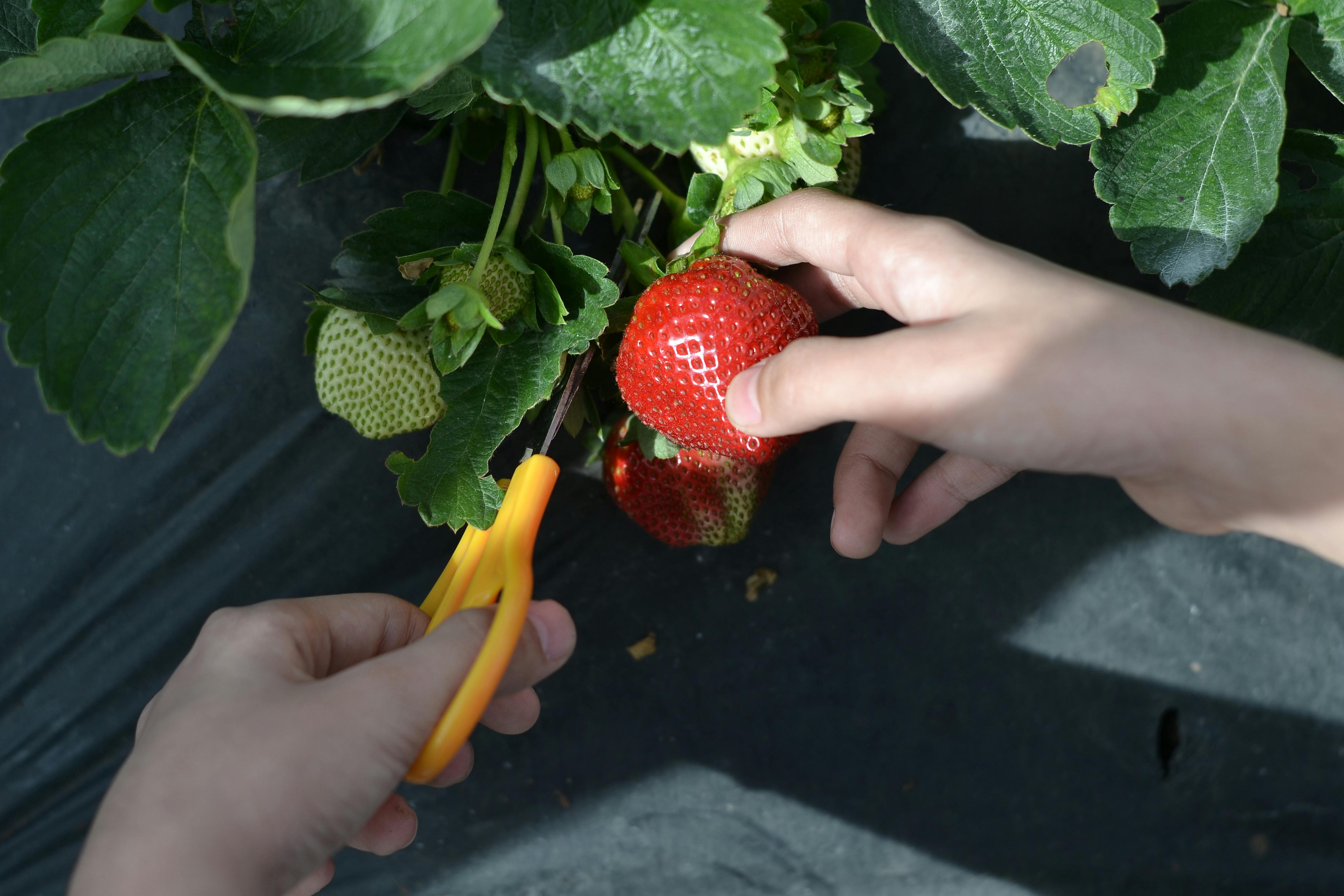Strawberries are one of the most popular and versatile fruits. They are easy to grow and can be planted in a variety of ways. One method of propagating strawberries is to cut and plant the runners. Runners are long, slender stems that emerge from the mother plant and can be used to start new plants. In this article, we will discuss how to cut and plant strawberry runners.Strawberry runners are a type of strawberry plant that produces fruit by sending out horizontal stems, or “runners,” from the main plant to root and form new plants. These runners will produce flowers, and eventually, fruit. Strawberry runners can be transplanted into other areas to start new strawberry beds.
Can Strawberry Runners Be Cut and Planted?
Yes, strawberry runners can be cut and planted. Runners are simply the long stems that grow out of the mother strawberry plant and produce new plants at the end. When allowed to grow, this process is known as “vegetative propagation”. The runner will produce its own roots at the end and can be planted in a separate container or in soil outdoors.
When cutting a runner, it is important to make sure that there are at least 2-3 leaves on it. This will ensure that the new plant has enough energy to create its own root system. Additionally, you should also make sure that you are cutting the runner from a healthy plant since this will give your new plant a better chance of survival.
Once you have chosen an appropriate runner, cut the stem just below a node or leaf joint using a sharp pair of scissors or knife. Once cut, you can either place it directly into soil or into a pot with suitable growing medium. Make sure to keep it moist until roots begin to form, which usually takes about two weeks. Once established, it is important to provide adequate sunlight and water for optimal growth.
With proper care, these runners can produce new plants within months of planting them, allowing gardeners to quickly expand their strawberry patch without having to purchase additional plants from nurseries or garden centers.
Overall, strawberry runners can be easily cut and planted with great success as long as some basic guidelines are followed regarding choosing healthy runners and providing adequate moisture and sunlight for optimal growth.
Where to Plant Strawberry Runners?
Strawberries are a delicious and nutritious fruit that can be grown in a variety of climates. When planting strawberries, it’s important to consider where to plant the runners. Runners are new plants that grow from the original strawberry plant and provide multiple plants in one area. The best place for a runner to take root is in an area with plenty of sun, soil that drains well, and access to water.
When selecting the planting site for strawberry runners, it’s important to make sure there is no standing water on the ground as this can lead to root rot and other diseases. The soil should be loose and rich in organic matter. This will help ensure that the plant receives adequate nutrients from the soil, as well as allowing for good drainage so that the plants don’t become waterlogged.
The location should also receive at least 6-8 hours of direct sunlight each day as this will help ensure healthy growth and optimal fruit production. It’s also important to select an area with plenty of space around it so that the runners have room to spread out and not become overcrowded. Finally, make sure the area has access to water so that you can easily irrigate your plants during dry spells or periods of drought.
By following these tips when selecting where to plant your strawberry runners, you’ll be sure they have everything they need for successful growth and fruit production!
Different Types of Strawberry Runners
Strawberry runners are a type of plant that produces runner plants, which are long vines that spread out from the mother plant. They can be used to propagate strawberry plants and create new plants from old ones. There are several different types of runners, each with its own advantages and disadvantages. The most common types of runners are:
Vegetative Runners
Vegetative runners are the most popular type of runner plant and they produce shoots or stems from the original plant that can be used to propagate new plants. These shoots can be planted in soil and will eventually take root and produce fruit-bearing plants. This type of runner is great for creating large, healthy strawberry beds as it allows for easy propagation and maintenance.
Aerial Runners
Aerial runners are similar to vegetative runners but instead, they produce shoots or stems from above ground level. These aerial stems can eventually root in soil and grow into a new plant, just like vegetative runners do. This type of runner is great for creating large berry patches quickly as it allows new plants to be added quickly without having to replant each one.
Stolon Runners
Stolon runners are a type of runner that produces stolons (or horizontal stems) which then take root in the soil and create a new plant. This type of runner is great for creating dense patches of strawberries as the stolons tend to spread out horizontally, allowing multiple shoots to grow from one parent plant.
Overall, there are several different types of strawberry runners available, each with its own benefits and drawbacks. When choosing which type is best for your needs, it’s important to consider your specific needs such as size, ease-of-propagation, maintenance requirements, etc., before making a decision
Preparing the Soil for Planting Strawberry Runners
When preparing the soil for planting strawberry runners, it is important to take into consideration several factors. The soil should be loose and well-draining, with a pH level between 5.5 and 6.0. It should also be amended with compost or aged manure to ensure that it has an adequate amount of nutrients for the plant to thrive. Additionally, the planting area should be free of weeds and other debris that could inhibit growth.
Before sowing the strawberry runners, it is important to till the soil to a depth of 6-8 inches in order to loosen it up and remove any rocks or other obstructions that may prevent adequate root growth. Additionally, any large clumps should be broken up and removed from the area before sowing. After tilling, small furrows can then be made in the soil in order to create rows for planting.
Once the rows have been prepared, it is then time to begin planting the strawberry runners. Each runner should be planted 1-2 inches deep into the soil at a distance of 8-12 inches apart in each row. After all of the runners have been planted, they should then be lightly mulched with straw or hay in order to help keep weeds away and maintain moisture levels in the soil.
Finally, once all of this has been done, watering can begin. The soil should remain damp throughout the growing season but not overly saturated as this can lead to root rot or other issues. With proper preparation and care, your strawberry runners will soon flourish into healthy plants!

Advantages of Planting Strawberry Runners
Strawberry runners are an economical and efficient way to propagate new strawberry plants. They are also easier to manage than other propagation methods, such as rooting cuttings or sowing seeds. Some of the advantages of planting strawberry runners include:
Cost savings – Planting strawberry runners is a cost-effective way to produce more plants. The cost of purchasing a single runner is much less than buying multiple seedlings or propagating from cuttings.
Quicker propagation – Propagating strawberry plants from runners is quick and easy. Once the runners have rooted and established themselves in the soil, they can be transplanted into their permanent location in just a few weeks.
Healthy plants – Since the parent plant has been growing successfully, it is likely that the runners will produce healthy, vigorous plants as well.
Ease of management – Strawberry runners are relatively easy to manage compared to other propagation methods, such as rooting cuttings or sowing seeds. The runners require minimal maintenance and do not need to be monitored closely for signs of disease or pests.
Increased yield – Planting strawberry runners can increase the yield of strawberries from one season to the next since each runner can produce multiple plants that will bear fruit in subsequent years.
How to Cut and Plant Strawberry Runners
Strawberry runners are a great way to propagate new strawberry plants. They are easy to cut and plant, and can be a cost-effective way of growing your own strawberry patch. Here is a step-by-step guide on how to cut and plant your own strawberry runners.
First, you will need to identify the best runners from the parent plant. These should be healthy, strong runners that have leaves at the tip. To cut the runner, use a pair of scissors or garden shears. Make sure to cut just below the leaf node at the end of the runner.
Once you have cut the runner, you can prepare it for planting. Strip off any leaves from the lower half of the runner so that only a few are left near the top. This will encourage root growth along its length and help it take root more easily in its new location.
Next, dig a small hole in your chosen planting spot and place your runner into it. Make sure that it is planted at an angle so that only one or two leaves remain above ground level and all other leaves are buried in the soil. Firmly tamp down around your runner with your hands so that it is securely in place.
Finally, water your newly planted strawberry runner thoroughly and keep an eye on its progress over time. With proper care, you should see new roots growing within a few weeks, and it should start producing strawberries in no time!
When is the Best Time to Cut and Plant Strawberry Runners?
Strawberry runners are new plants that are created from an existing strawberry plant. These new plants can be cut away from the mother plant and then planted in a different spot. Knowing when to cut and plant strawberry runners is key to getting the most out of your strawberry harvest.
The best time to cut and plant strawberry runners is in late summer or early fall when the weather is still warm but not too hot. This gives the new plants enough time to establish themselves before the cold weather sets in. It’s important to make sure that you cut off the runners at least a few weeks before the first frost of the season, otherwise you risk damaging or killing your new plants.
When cutting off your strawberry runners, make sure that you use sharp pruning shears or scissors and cut as close to the mother plant as possible without damaging it. Once you’ve got your runner, be sure to immediately transplant it into well-draining soil in an area with at least six hours of direct sunlight per day. Depending on where you live, you may want to add some mulch around your new plant to help keep it warm during colder months.
It’s also important to be aware of any pests or diseases that could be present in your area before planting your strawberry runners. If there are signs of any kind of infection or infestation, it’s best to avoid planting in that area until the problem has been taken care of.
Finally, don’t forget about regular maintenance for your strawberry runners once they have been planted. This includes watering them regularly and providing them with adequate nutrients for optimal growth and development. Additionally, keep an eye out for pests and disease which may affect their health over time. With these steps taken care of, you can enjoy a bountiful harvest of fresh strawberries each year!

Conclusion
Strawberry runners can be cut and planted with relative ease. The process is simple and straightforward, making it ideal for gardeners of all levels. Plus, runners produce a consistent crop of healthy strawberries in the same spot year after year. This makes them a great choice for those who want to ensure they have a ready supply of sweet strawberries on hand.
It’s important to note, however, that runners should only be cut and planted from June through August when the plants are actively growing. Additionally, it’s wise to keep an eye on the health of the runner plant so that it continues to produce healthy fruits in the years to come. With proper care and attention, strawberry runners can remain productive sources of delicious berries for many seasons.



